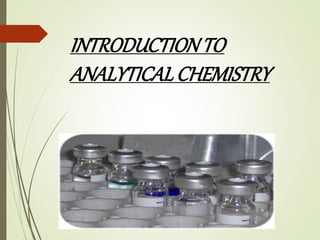
Introduction to Analytical Chemistry
- 2. Analytical chemistry Analytical chemistry is the study of the separation, identification, and quantification of the chemical components of natural and artificial materials.
- 3. HISTORICAL BACKGROUND Analytical chemistry has been important since the early days of chemistry, providing methods for determining which elements and chemicals are present in the object in question. During this period significant analytical contributions to chemistry include the development of systematic elemental analysis by Justus von Liebig and systematized organic analysis based on the specific reactions of functional groups.
- 4. The first instrumental analysis was flame emissive spectrometry developed by Robert Bunsen and Gustav Kirchhoff who discovered rubidium (Rb) and cesium (Cs) in 1860.
- 5. Qualitative analysis is what. Quantitative analysis is how much.
- 6. Classical methods Although modern analytical chemistry is dominated by sophisticated instrumentation, the roots of analytical chemistry and some of the principles used in modern instruments are from traditional techniques many of which are still used today. These techniques also tend to form the backbone of most undergraduate analytical chemistry educational labs. Qualitative analysis: A qualitative analysis determines the presence or absence of a particular compound, but not the mass or concentration. By definition, qualitative analyses do not measure quantity. The presence of copper in this qualitative analysis is indicated by the bluish-green color of the flame.
- 7. Chemical tests There are numerous qualitative chemical tests, for example, the acid test for gold and the Kastle-Meyer test for the presence of blood. Flame test Inorganic qualitative analysis generally refers to a systematic scheme to confirm the presence of certain, usually aqueous, ions or elements by performing a series of reactions that eliminate ranges of possibilities and then confirms suspected ions with a confirming test. Sometimes small carbon containing ions are included in such schemes. With modern instrumentation these tests are rarely used but can be useful for educational purposes and in field work or other situations where access to state-of-the- art instruments are not available or expedient.
- 8. Quantitative analysis Gravimetric analysis: Gravimetric analysis involves determining the amount of material present by weighing the sample before and/or after some redetermination of the amount of water in a hydrate by heating the sample to remove transformation. A common example used in undergraduate education is the the water such that the difference in weight is due to the loss of water.
- 9. Volumetric analysis Titration involves the addition of a reactant to a solution being analyzed until some equivalence point is reached. Often the amount of material in the solution being analyzed may be determined. Most familiar to those who have taken chemistry during secondary education is the acid-base titration involving a color changing indicator. There are many other types of titrations, for example potentiometric titrations. These titrations may use different types of indicators to reach some equivalence point.
- 10. Different methods provide a range of precision, sensitivity, selectivity, and speed capabilities.
- 11. Instrumental methods Spectroscopy Spectroscopy measures the interaction of the molecules with electromagnetic radiation. Spectroscopy consists of many different applications such as atomic absorption spectroscopy, atomic emission spectroscopy, ultraviolet- visible spectroscopy, x-ray fluorescence spectroscopy, infrared spectroscopy, Raman spectroscopy, dual polarisation interferometry, nuclear magnetic resonance spectroscopy, photoemission spectroscopy, Mössbauer spectroscopy and so on. Block diagram of an analytical instrument showing the stimulus and measurement of response
- 12. Mass spectrometry Mass spectrometry measures mass-to- charge ratio of molecules using electric and magnetic fields. There are several ionization methods: electron impact, chemical ionization, electrospray, fast atom bombardment, matrix assisted laser desorption ionization, and others. Also, mass spectrometry is categorized by approaches of mass analyzers: magnetic-sector, quadrupole mass analyzer, quadrupole ion trap, time-of- flight, Fourier transform ion cyclotron resonance, and so on.
- 13. Electrochemical analysis Electroanalytical methods measure the potential (volts) and/or current (amps) in an electrochemical cell containing the analyte. These methods can be categorized according to which aspects of the cell are controlled and which are measured. The three main categories are potentiometry (the difference in electrode potentials is measured), coulometry (the cell's current is measured over time), and voltammetry (the cell's current is measured while actively altering the cell's potential). • High-speed and supersensitive measurement is possible. • Electrodes of any shape can be fabricated. • Applicable to the control of chemical reaction processes and liquid chromatography mass spectrometer.
- 14. Thermal analysis Calorimeter and thermo gravimetric analysis measure the interaction of a material and heat. Separation Separation processes are used to decrease the complexity of material mixtures. Chromatography, electrophoresis and Field Flow Fractionation are representative of this field.
- 15. Hybrid techniques Combinations of the above techniques produce a "hybrid" or "hyphenated" technique. Several examples are in popular use today and new hybrid techniques are under development. For example, gas chromatography-mass spectrometry, gas chromatography- infrared spectroscopy, liquid chromatography-mass spectrometry, liquid chromatography-NMR spectroscopy. liquid chromagraphy- infrared spectroscopy and capillary electrophoresis-mass spectrometry.
- 16. Hyphenated separation techniques refers to a combination of two (or more) techniques to detect and separate chemicals from solutions. Most often the other technique is some form of chromatography. Hyphenated techniques are widely used in chemistry and biochemistry. A slash is sometimes used instead of hyphen, especially if the name of one of the methods contains a hyphen itself. Gas chromatography mass spectrometry schematic
- 17. Microscopy The visualization of single molecules, single cells, biological tissues and nanomaterials is an important and attractive approach in analytical science. Also, hybridization with other traditional analytical tools is revolutionizing analytical science. Microscopy can be categorized into three different fields: optical microscopy, electron microscopy, and scanning probe microscopy. Recently, this field is rapidly progressing because of the rapid development of the computer and camera industries. Fluorescence microscope image of two mouse cell nuclei in prophase (scale bar is 5 µm).